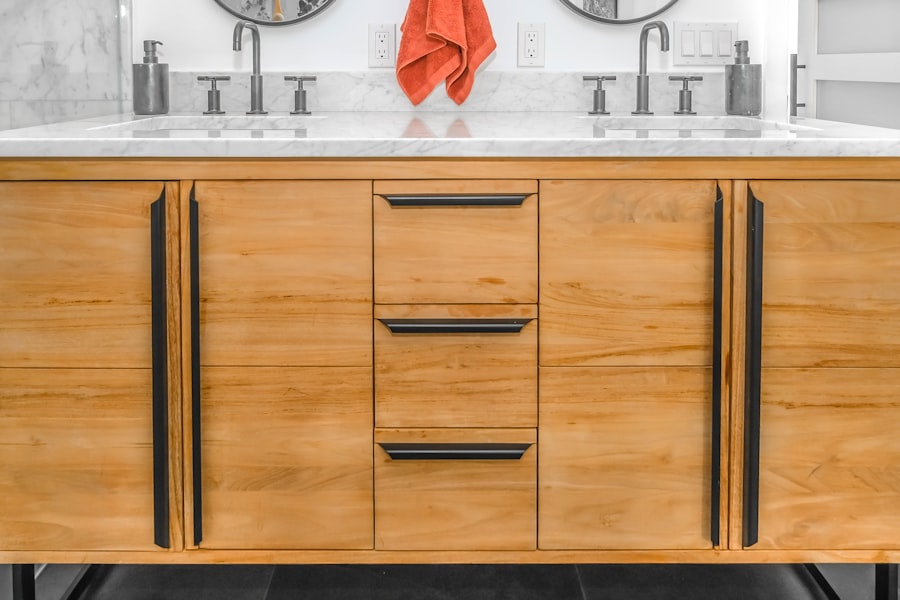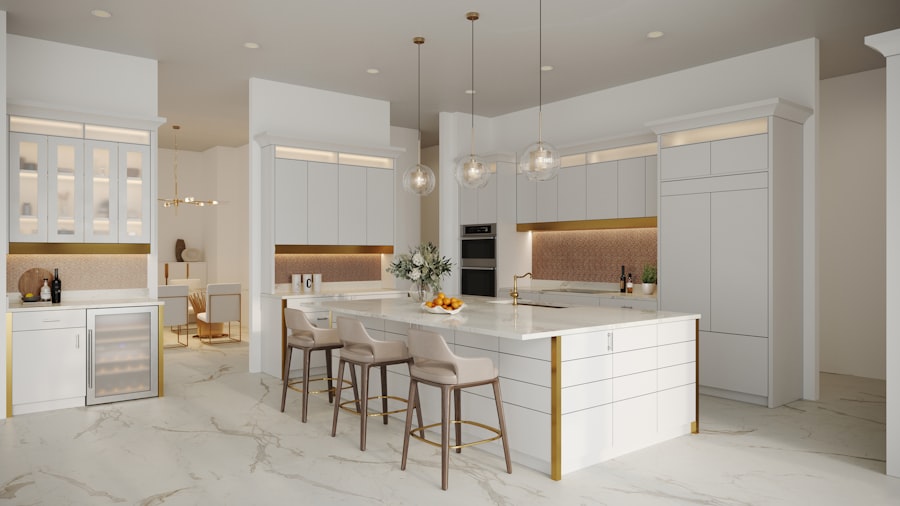The realm of cabinet design has undergone a remarkable transformation in recent years, driven by advancements in technology, changing consumer preferences, and a growing emphasis on sustainability. As kitchens and bathrooms evolve into multifunctional spaces that reflect personal style and enhance functionality, the innovations in cabinet design have become pivotal in shaping these environments. From the integration of smart technology to the use of eco-friendly materials, the modern cabinet is no longer just a storage solution; it is a statement piece that embodies both aesthetic appeal and practical utility.
Cabinet design innovations are not merely about aesthetics; they also address the challenges posed by contemporary living. As urbanization continues to rise, many homeowners find themselves contending with limited space, necessitating creative solutions that maximize utility without compromising style. Furthermore, the increasing awareness of environmental issues has prompted designers and manufacturers to explore sustainable materials and practices.
This article delves into various aspects of cabinet design innovations, highlighting how they cater to the needs of modern homeowners while enhancing the overall functionality and appeal of living spaces.
Key Takeaways
- Cabinet design innovations focus on enhancing functionality and aesthetics in modern kitchens.
- Space-saving solutions are essential for maximizing efficiency in small kitchen areas.
- Integration of smart technology improves convenience and usability in cabinet designs.
- Sustainable materials are increasingly used to promote eco-friendly cabinet construction.
- Customization options allow homeowners to personalize cabinets to fit their unique needs and style.
Space-Saving Solutions for Small Kitchens
In urban settings where square footage is at a premium, space-saving solutions have become essential for small kitchens. Innovative cabinet designs now incorporate features that optimize every inch of available space. For instance, pull-out cabinets and drawers can be strategically placed in corners or under countertops, allowing homeowners to utilize areas that would otherwise remain unused.
These designs not only enhance accessibility but also create a more organized kitchen environment, making it easier to find and store kitchen essentials. Another popular trend in space-saving cabinet design is the use of vertical storage solutions. Tall cabinets that extend to the ceiling can house a variety of items, from pantry staples to small appliances, effectively reducing clutter on countertops.
Additionally, modular cabinetry systems allow for customization based on individual needs, enabling homeowners to create a layout that maximizes functionality while maintaining an open and airy feel. By integrating these space-saving solutions, small kitchens can transform into efficient workspaces that cater to the demands of modern cooking and entertaining.
Smart Technology Integration in Cabinet Design

The integration of smart technology into cabinet design represents a significant leap forward in enhancing kitchen functionality. Smart cabinets equipped with sensors can automatically open with a simple touch or voice command, providing hands-free access when cooking or carrying items. This innovation not only adds convenience but also promotes hygiene by minimizing contact with surfaces.
Furthermore, smart cabinets can be integrated with home automation systems, allowing users to monitor inventory levels and receive alerts when supplies are running low. Another exciting development in smart cabinet technology is the incorporation of built-in charging stations and wireless charging pads. Homeowners can now keep their devices charged and within reach while cooking or entertaining, eliminating the need for unsightly cords and cluttered countertops.
Additionally, some cabinets feature integrated lighting systems that can be adjusted based on the time of day or activity, enhancing both functionality and ambiance. As smart technology continues to evolve, its integration into cabinet design will undoubtedly redefine how we interact with our living spaces.
Sustainable and Eco-Friendly Materials in Cabinet Construction
| Material | Source | Environmental Impact | Durability | Recyclability | Typical Use in Cabinet Construction |
|---|---|---|---|---|---|
| Bamboo | Rapidly renewable grass | Low carbon footprint, biodegradable | High | High | Cabinet panels, flooring, veneers |
| Reclaimed Wood | Recycled from old buildings or furniture | Reduces deforestation, waste reduction | High (depends on original wood) | High | Cabinet frames, doors, decorative elements |
| Recycled MDF (Medium Density Fiberboard) | Post-consumer wood fibers | Reduces landfill waste, uses less virgin wood | Moderate | Moderate | Cabinet carcasses, shelving |
| Cork | Bark of cork oak tree (harvested sustainably) | Renewable, biodegradable, carbon sequestration | Moderate | High | Cabinet panels, drawer liners |
| Low-VOC Finishes | Plant-based or water-based coatings | Reduces indoor air pollution | Varies | Varies | Surface finishing of cabinets |
| Recycled Metal Hardware | Scrap metal reprocessed | Reduces mining impact, energy savings | High | High | Handles, hinges, drawer slides |
As environmental consciousness grows among consumers, the demand for sustainable and eco-friendly materials in cabinet construction has surged. Manufacturers are increasingly turning to materials such as bamboo, reclaimed wood, and recycled composites that not only reduce environmental impact but also offer unique aesthetic qualities. Bamboo, for instance, is a rapidly renewable resource that boasts durability and resistance to moisture, making it an ideal choice for kitchen cabinets.
In addition to material selection, sustainable practices in manufacturing processes are gaining traction. Many companies are adopting low-VOC (volatile organic compounds) finishes and adhesives that minimize harmful emissions during production and throughout the lifecycle of the cabinets. This commitment to sustainability not only appeals to environmentally conscious consumers but also contributes to healthier indoor air quality.
By prioritizing eco-friendly materials and practices, cabinet manufacturers are paving the way for a more sustainable future in home design.
Customization and Personalization Options for Cabinets
The trend toward customization and personalization in cabinet design reflects a broader shift toward creating spaces that resonate with individual lifestyles and preferences. Homeowners are increasingly seeking cabinetry solutions that align with their unique tastes, whether through color choices, finishes, or hardware selections. Custom cabinetry allows for tailored designs that fit specific dimensions and layouts, ensuring that every inch of space is utilized effectively.
Moreover, personalization extends beyond aesthetics; it encompasses functional features as well. Homeowners can choose from a variety of organizational options such as pull-out shelves, built-in dividers, and specialized compartments for utensils or spices. This level of customization not only enhances usability but also allows individuals to express their personal style within their homes.
As the demand for bespoke cabinetry continues to rise, manufacturers are responding by offering an array of options that cater to diverse tastes and functional needs.
Innovative Organization and Access Solutions

The evolution of cabinet design has brought forth innovative organization and access solutions that significantly enhance kitchen efficiency. One notable advancement is the introduction of pull-out pantry systems that maximize vertical space while providing easy access to stored items. These systems often feature adjustable shelves and clear containers that allow homeowners to see their inventory at a glance, reducing food waste and streamlining meal preparation.
Additionally, lazy Susans and pull-down racks have become popular features in modern cabinetry. Lazy Susans enable easy access to corner cabinets that would otherwise be difficult to reach, while pull-down racks provide convenient storage for heavier items like pots and pans without straining one’s back. These innovative solutions not only improve organization but also promote a more ergonomic kitchen environment, making cooking and cleaning tasks more manageable.
Trends in Cabinet Hardware and Finishes
The aesthetic appeal of cabinets is greatly influenced by hardware choices and finishes, which have seen significant trends in recent years. Minimalist designs featuring sleek handles or even handle-less options are gaining popularity as homeowners seek clean lines and uncluttered looks. Matte finishes in various colors are also trending, offering a modern alternative to traditional glossy surfaces while providing a sophisticated touch.
In addition to aesthetics, hardware functionality has evolved as well. Soft-close hinges and drawer slides have become standard features in high-quality cabinetry, ensuring quiet operation and preventing slamming. Furthermore, customizable hardware options allow homeowners to select pieces that reflect their personal style—whether opting for vintage-inspired knobs or contemporary pulls made from sustainable materials.
These trends highlight the importance of hardware not just as functional components but as integral elements of overall cabinet design.
The Impact of Cabinet Design Innovations on Home Value
The innovations in cabinet design have far-reaching implications for home value, particularly in key areas like kitchens and bathrooms where cabinetry plays a central role in functionality and aesthetics. High-quality cabinetry with modern features can significantly enhance a home’s appeal to potential buyers. For instance, homes equipped with smart cabinets or sustainable materials often attract environmentally conscious buyers who prioritize energy efficiency and modern conveniences.
Moreover, well-designed cabinets contribute to an organized and visually appealing space, which can influence buyers’ perceptions during showings or open houses. A kitchen with innovative storage solutions not only appears more spacious but also suggests a higher level of care in home maintenance. As such, investing in contemporary cabinet designs can yield substantial returns when it comes time to sell a property.
The integration of innovative features not only elevates the living experience but also positions homes favorably within competitive real estate markets. In conclusion, the landscape of cabinet design is continuously evolving, driven by technological advancements, sustainability efforts, customization demands, and changing consumer preferences. As homeowners seek solutions that enhance both functionality and aesthetic appeal, innovations in cabinet design will remain at the forefront of home improvement trends.



